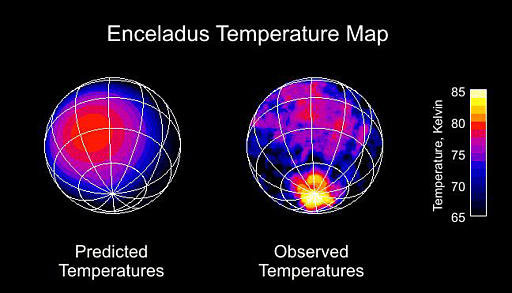Theory: Saturn Moon's Heat From Decay

LOS ANGELES(AP) -- Scientists believe heat from radioactive decay inside a tiny, icy Saturnmoon shortly after it formed billions of years ago may explain why geysers areerupting from the surface today. The Cassini spacecraft last year beamed backdazzling images of Yellowstone-like geysers spewing from a warm section onEnceladus, raising the possibility that the moon, which has an overall surfacetemperature of about minus-330 degrees, may have an internal environmentsuitable for primitive life.
However,scientists have been stumped by the origin of Enceladus' interior heat. Now anew model suggests ancient radioactive decay played a key role in shaping themoon's warm south pole region, where plumes of water vapor and ice crystalsperiodically vent.
Accordingto the theory, Enceladus formed some 4.5 billion years ago by the mixing of iceand rock containing radioactive isotopes of aluminum and iron. Over a period ofseveral million years, the rapid decay of the isotopes produced a burst of heatthat resulted in a rocky core enclosed by an ice sheet. Over time, theremaining decomposition in the core further warmed and melted the moon'sinterior.
Ifconfirmed, the model suggests Enceladus possesses the necessary ingredients tosupport life -- a stable heat source, organic materials and liquid water.
"It tellsus that conditions inside Enceladus either were or still are conducive tobiochemical reactions,'' project scientist Dennis Matson said in a telephoneinterview.
Resultswere presented Monday at the annual Lunar and Planetary Science Conference in Texas and will be published in the April issue of the astronomical journal Icarus.
The Cassiniteam previously theorized that the geysers likely came from undergroundreservoirs of water close to the surface, indicating a lasting heat sourceinside. Matson said the latest model helps explain where the interior heatmight have come from.
Breaking space news, the latest updates on rocket launches, skywatching events and more!
Last year,another research team published a study that cast doubt on the existence ofwater near Enceladus' surface. That study suggested that buried ice clathrates --not liquid water -- were responsible for releasing the plumes through a tectonicshift in the crust. Clathrates are lattice-like molecular structures that trapother types of molecules.
Cassini scientistsplan to measure the composition of the gas rising from the plume during anEnceladus flyby in 2008.
The Cassinimission is a project of NASA, the European Space Agency and the Italian SpaceAgency. Launched in 1997, the spacecraft entered orbit around Saturn in 2004,exploring its rings and moons.
- Moon of Saturn Sprays Cosmic Graffiti
- Encore For Enceladus! Saturn Moon Ripe For Astrobiology Exploration
- Video: Enceladus - Old Faithful
- Image: Icy Enceladus
Alicia is a former contributing writer for Space.com working in the areas of Space Exploration and Human Spaceflight. She's currently a health and science editor for The Associated Press in New York, where she's been employed since 2017. She's a 2018 Tow-Knight entrepreneurial journalism fellow at the CUNY Graduate School of Journalism and was a 2015–16 Knight Science Journalism fellow at the Massachusetts Institute of Technology.
